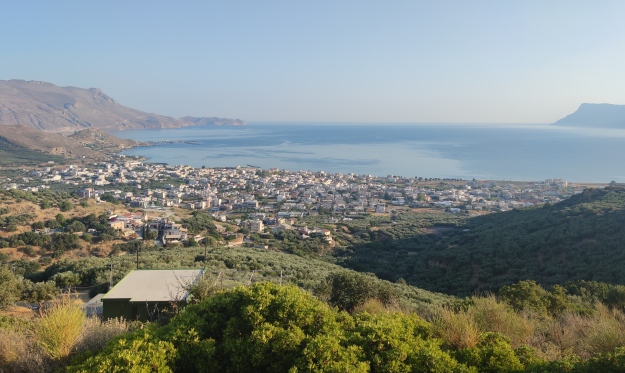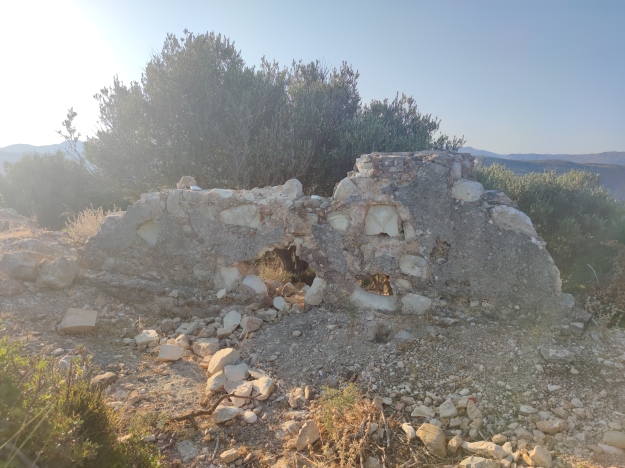While European forces concentrated on the major towns on the northern coast of Crete, in the early stages of the Intervention the smaller town of Kastelli Kissamos, on the north western coast of Crete, was occupied by Ottoman forces. Partially because of the presence of smallpox in the town[1], the European role appears to have consisted of providing naval support for the Ottoman garrison.
In March 1897 H.M.S. Rodney, under Austro-Hungarian command, the Austro-Hungarians still being part of the concert at this stage and responsible for naval activity around the western side of the island, became involved in discouraging Cretan Christians attacking the Ottoman garrison of the town. On 29th March 1897, Captain W. Hewitt, H.M.S. Rodney, reported to Admiral Harris that on the 28th after firing two rounds blank from her 6 pounder, the Rodney opened fire on Cretan Christian insurgents attempting to mine the walls of Kastelli Kissamos. In total some 13 rounds were fired at a distance of 2100 yards, with Rodney’s steam pinnace contributing a further four rounds from her 2 pounder gun.
Over the following day two days, landing parties consisting of 200 British sailors and marines and 130 Austro-Hungarians went ashore to pull down the house near the Ottoman fortifications.[2] The accompanying text to the illustration below, taken from the Graphic of 24 April 1897, states that three houses were demolished to prevent their use by the insurgents.

Demolition of houses in Kastelli Kissamos.
A month later, on 9th April, the Royal Navy was again in action off Kissamos. In company with, and under the command of S.M.S. Sebenico, H.M.S. Fearless, a Scout Class Torpedo Cruiser captained by Commander Charles E. Gladstone, was involved in evacuating women and children from the Ottoman fort when their boats were fired on by insurgents. Both the Austro-Hungarian and the British ships opened fire to cover the embarkation. Over the next few days two Ottoman blockhouses (κουλέ) were evacuated and one set on fire to destroy it, the other apparently had nothing flammable in it. On 12th April the senior Austro-Hungarian Senior Officer informed Commander Gladstone that in order to deny them to the insurgents, it had been decided to destroy the blockhouses by naval gunfire.
“All ships present opened fire on the east block-house, distant 3,800 yards, and expended a considerable amount of ammunition. The result was that the walls were knocked down to a certain extent, but the ruins remain just as effective as a protection for riflemen as they were before, and it would be an impossible task to level the building to the ground by gunfire.” [3]

Kissamos. View of town from Eastern κουλέ 2022. (Alexandros Savopoulos)

Kissamos. Remains of Eastern κουλέ 2022. (Alexandros Savopoulos)

Kissamos. Remains of Eastern κουλέ 2022. (Alexandros Savopoulos)

H.M.S. Fearless.
‘The latest authentic news from Kissamos Kastelli, where the insurgents are pressing hard upon the Turkish garrison, is that the Austrian gun-boat [SMS] Sebenico has succeeded in taking off about, I believe, one hundred women and children The blue-jackets were repeatedly fired on during the operation reconnaissance’s from the war-ships have completely failed to discover the five guns which the insurgents were reported to have placed position. The [HMS] Fearless, third-class cruiser, which is now at Kissaimos (sic), is likely to remain there, since it is an Austrian station; and Captain Rainier, of the [HMS] Rodney, who returned to duty on Saturday, is senior to the Austrian captain, who directed the operations during his absence from illness. An English cattle-steamer has been captured by a cruiser, its commander being unable to produce the proper papers. In future, every British vessel will obliged to carry a prearranged document, setting forth its character, destination, and other formal particulars.’
St James’ Gazette 12 April 1897
Many thanks to Alexandros Savopoulos for providing the photographs of the koules and permitting me to use them.
[1] National Archive. ADM 116/88. Enclosure 142. Rear Admiral Harris to Admiralty. 6th April 1897.
[2] National Archive. ADM 116/92. Enclosure 146.6. Captain W. Hewitt to Rear Admiral Harris. 29th March 1897.
[3] National Archive. ADM 116/92. Enclosure 185. Commander Gladstone to Rear Admiral Harris. 14th April 1897.














